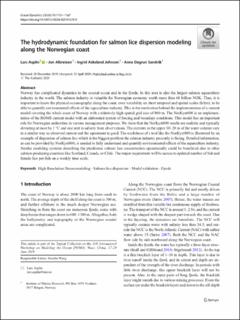| dc.contributor.author | Asplin, Lars | |
| dc.contributor.author | Albretsen, Jon | |
| dc.contributor.author | Johnsen, Ingrid A. | |
| dc.contributor.author | Sandvik, Anne Dagrun | |
| dc.date.accessioned | 2020-10-16T11:40:16Z | |
| dc.date.available | 2020-10-16T11:40:16Z | |
| dc.date.created | 2020-05-14T08:43:32Z | |
| dc.date.issued | 2020 | |
| dc.identifier.citation | Ocean Dynamics. 2020, 70 1151-1167. | en_US |
| dc.identifier.issn | 1616-7341 | |
| dc.identifier.uri | https://hdl.handle.net/11250/2683338 | |
| dc.description.abstract | Norway has complicated dynamics in the coastal ocean and in the fjords. In this area is also the largest salmon aquaculture industry in the world. The salmon industry is valuable for Norwegian economy worth more than 60 billion NOK. Thus, it is important to know the physical oceanography along the coast, even variability on short temporal and spatial scales (h/km), to be able to quantify environmental effects of the aquaculture industry. This is the motivation behind the implementation of a current model covering the whole coast of Norway with a relatively high spatial grid size of 800 m. The NorKyst800 is an implementation of the ROMS current model with an elaborated system of forcing and boundary conditions. This model has an important role for Norwegian authorities in various management purposes. We show that the NorKyst800 results are realistic and typically deviating at most by 1 °C and one unit in salinity from observations. The currents in the upper 10–20 m of the water column vary in a similar way as observed current and the agreement is good. The usefulness of a tool like the NorKyst800 is illustrated by an example of dispersion of salmon lice which is the biggest problem the salmon industry presently is facing. Detailed information, as can be provided by NorKyst800, is needed to fully understand and quantify environmental effects of the aquaculture industry. Similar modeling systems describing the planktonic salmon lice concentration operationally could be beneficial also in other salmon-producing countries like Scotland, Canada, or Chile. The major requirement will be access to updated number of fish and female lice per fish on a weekly time scale. | en_US |
| dc.language.iso | eng | en_US |
| dc.title | The hydrodynamic foundation for salmon lice dispersion modeling along the Norwegian coast | en_US |
| dc.type | Peer reviewed | en_US |
| dc.type | Journal article | en_US |
| dc.description.version | publishedVersion | en_US |
| dc.source.pagenumber | 1151-1167 | en_US |
| dc.source.volume | 70 | en_US |
| dc.source.journal | Ocean Dynamics | en_US |
| dc.identifier.doi | 10.1007/s10236-020-01378-0 | |
| dc.identifier.cristin | 1810899 | |
| dc.relation.project | Havforskningsinstituttet: 14894 | en_US |
| cristin.ispublished | true | |
| cristin.fulltext | original | |
| cristin.qualitycode | 1 | |
